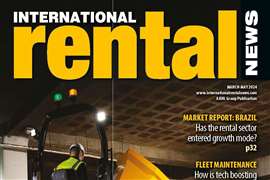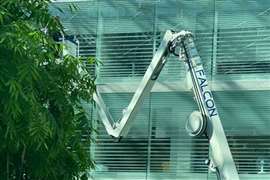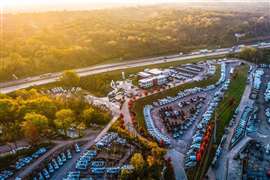Liebherr has developed a tower crane for installing wind turbines
24 April 2012

Liebherr has developed a tower crane for installing wind turbines. Its capabilities outclass those of a mobile or crawler crane in certain locations, the manufacturer says. Euan Youdale reports
The new Liebherr 630 EC-H 70 Litronic tower crane is designed to erect wind turbines with hub heights of more than 110 metres. As a rule, according to Liebherr, these are large turbines in areas where wind speed is low at ground level and they are not found grouped together on large wind farms. Rather, they are usually situated in wooded areas and other difficult to access locations, where the advantages of a tower crane comes into its own.
"These [advantages] include fewer transport vehicles, which do not need any special approvals or access on roadways, which also do not need any special strengthening; and much less surface area is needed for the assembly of the tower crane and of the wind power system itself," commented Robert Strohmaier, Liebherr project manager.
Liebherr developed the 630 EC-H 70 Litronic with Germany-based construction company Max Bögl Wind AG to erect new generation 3 MW Vestas V 112 hybrid turbines with 140 m hub height. It was first used at Bischberg in the Oberpfalz region of Germany, where it erected three turbines and achieved a height under hook of 151.1 metres, using just one guying system attached to the wind turbine tower. The crane can operate free-standing up to a height under hook of 93.1 m, added Strohmaier.
To erect the tower, nacelle and blades of these turbines, the 630 EC-H 70 requires a lifting capacity of 70 tonnes. At the maximum radius of 30.9 m lifting capacity is 10.7 tonnes.
Features
The 630 EC-H 70 Litronic is integrated into the foundation of the wind turbine and stands very close to the turbine tower. This means the assembly of the crane and wind turbine requires a minimal 1,200 m² of space, said Strohmaier, "This is just 40% of the usual area in comparison with other crane systems; a major bonus when it comes to working in wooded areas or locations with difficult access."
Transportation logistics are also simple compared to delivering a mobile or crawler crane to site, said Strohmaier, because the individual components can be delivered in much smaller pieces. "This means a small number of vehicles are needed to transport the crane. For the project in Bischberg, with a hub height of 140 m, only 21 trucks were required, most of them conventional semi-trailers."
The crane is mounted on a reusable foundation frame, which means smaller tower cranes can still be economically mounted on it to carry out service work on the nacelle or the blades throughout the turbine's life, added Strohmaier.
Assembly
In the first stage of assembly, a mobile crane is used to erect the crane to a free-standing height under hook of 93.1 m. The tower crane is then attached to the wind turbine tower at about 82 m using Liebherr's patented guying system. "This new development means that even for the enormous height under hook of 151.1 m, only one guying arrangement was needed," Strohmaier explained.
Once attached, the crane self-climbs quickly and safely using the manufacturer's climbing device in stages of 5.8 m, up to the final 151.1 m height under hook. "In most cases wind conditions at wind power system sites are likely to be rough, which could impair the operation of the crane," said Strohmaier. "Tower cranes can function at wind speeds of up to 20 m/s, another advantage which the assembly crew found very impressive. It is only when the wind reaches speeds in excess of 120 km/h that the jib of the 630 EC-H 70 has to be released to turn [weathervane] freely."
In such restricted spaces, laying down the jib of a mobile crane for assembly is often not possible. Of course, using a tower, means this is not necessary in the first place, Strohmaier explained. "That, in turn, saves a great deal of time and expense in the preparation of the transport and operating areas around the wind power installation."
Fast winching
Another advantage comes from the high-powered hoisting gear with lifting speeds up to 37 m/min. "Particularly impressive in this situation was the short lifting times for the heavy concrete rings and the nacelle, which were raised at 8 m/min," said Strohmaier. In less than half an hour the 70 tonne nacelle had been safely hoisted to a height of 140 m.
As with the blades, its attachment to the tower required delicate, millimetre precision. Thanks to the position of the cab at eye-level with the nacelle, the 630 EC-H 70 operator gets a good view. Using the trolley jib to place the concrete tower rings, hub and rotor blades contributed to a safe, rapid and precise assembly, added Strohmaier. "With the addition of the Micromove fine positioning mode, even the heaviest parts were safely and securely installed by the assembly team because this arrangement enables swaying movements of the suspended elements of the system to be avoided."
These are all arguments "in favour of the concept of assembling wind power installations using tower cranes," Strohmaier concluded.






